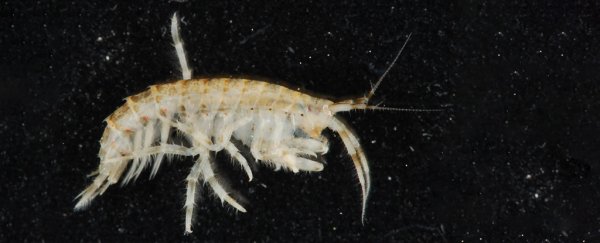Microplastics are widespread in seas and oceans, and their harmful effects on many different marine animals are well known. However, we know relatively little about the microplastics in our freshwater rivers, streams and lakes.
We still don't know exactly where they come from, where they end up – and crucially – what damage they can cause if they get into food chains.
Until now, plastic fragmentation had largely been attributed to processes such as sunlight or wave action, which can take years or decades. But it turns out a tiny shrimp-like creature can do the same job much faster.
I am a researcher who specialises in microplastics in the environment. In my latest study, colleagues and I have shown that microplastics (plastic pieces smaller than 5 mm) in freshwaters are being broken down into even smaller nanoplastics (smaller than one micrometre, at least five thousand times smaller in size) by a type of freshwater invertebrate animal, and that this may happen much faster than previously estimated.
 Fragmented microplastics in an amphipod (left); a nanoplastic fragment (right). (Alicia Mateos Cardenas)
Fragmented microplastics in an amphipod (left); a nanoplastic fragment (right). (Alicia Mateos Cardenas)
Our results, newly published in the Nature journal Scientific Reports, highlight the role of biological fragmentation of microplastics, which has been understudied so far.
The animal in question is a 2 cm-long crustacean, the freshwater amphipod Gammarus duebeni. This specific species lives in Irish streams, but it belongs to a bigger group of invertebrates that are common in both freshwater and the oceans around the world.
Our finding therefore has big consequences for how we understand the environmental fate of microplastics.
Our first experiments had been carried out to understand the potential negative effects (if any) of microplastics in the amphipods. However, some surprising early results led me to run new experiments focused on gathering evidence to show that microplastics were being fragmented biologically – by G. duebeni themselves.
In order to find out about this, I exposed the amphipods in the laboratory to a certain type of microplastics that have a specific colour dye. I then dissected the digestive tracts of the amphipods and visualised them under a fluorescence microscope, which is able to track the dyed-microplastic in animal tissue.
We then concluded that Gammarus duebeni is able to fragment microplastics into different shapes and sizes, including nanoplastics, in less than four days.
We were able to track such fragmentation because the microplastics that we used were originally "microbeads" with a perfect spherical shape. Any plastic with irregular shapes therefore must have been fragmented by the animals, and nearly 66 percent of the microplastics found in the guts had indeed been fragmented in this way.
Remarkably, the proportion of smaller plastic fragments was highest when the amphipods were "purged" in the lab in a clean environment with no plastics but with their food. This finding indicates that biological fragmentation could be closely related to the feeding process.
We also ran some quality control checks, several side experiments to make sure that the plastic was indeed being fragmented by the amphipods and not some other source, and that we were accurately visualising the fluorescence particles.
 Gammarus duebeni lives in freshwater, like this stream in County Cork, Ireland. (Alicia Mateos Cardenas)
Gammarus duebeni lives in freshwater, like this stream in County Cork, Ireland. (Alicia Mateos Cardenas)
Microplastics in the food chain
Why does this matter? We already know that microplastics can accumulate in the gut of seabirds and fish, and our current understanding is that the smaller nanoplastic particles could even penetrate cells and tissues, where their effects could be much harder to predict.
Therefore the finding that such a common animal can rapidly produce vast numbers of nanoplastics is particularly worrying. Since the crustaceans we looked at are eaten by fish and birds, any nanoplastic fragments that they produce may also be entering the food chain.
For example, scientists at the University of Cardiff recently showed for the first time that microplastics had been transferred up the food chain in a river, from small invertebrates through to dippers, the only songbird that can swim underwater. They looked at dipper regurgitates and faecal pellets from both adults and chicks and found microplastics in all of them.
We still don't know exactly what effect this microplastic transfer will have on the birds, especially in the early stages of their lives. But our results on the biological fragmentation of microplastics will help us to understand the role that animals can have in determining the fate of plastics in our waters. ![]()
Alicia Mateos Cárdenas, Postdoctoral Researcher, University College Cork.
This article is republished from The Conversation under a Creative Commons license. Read the original article.
